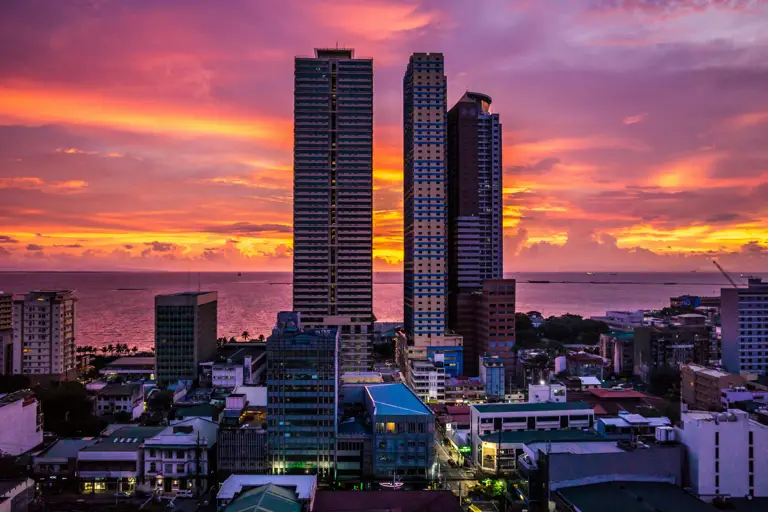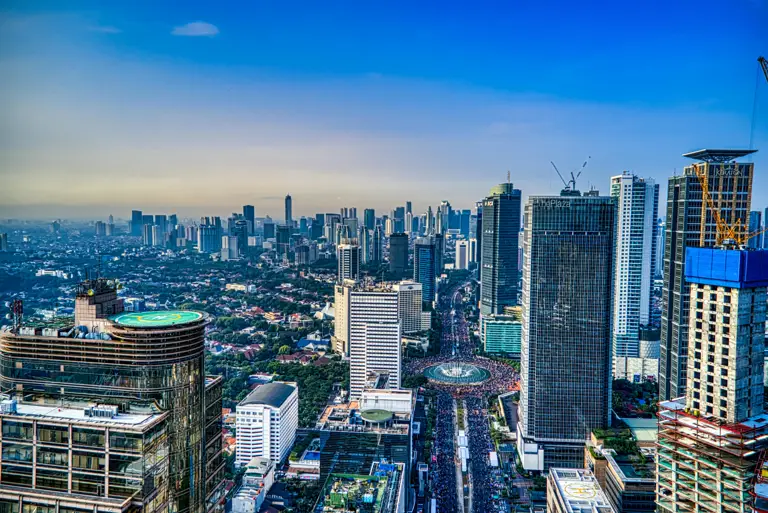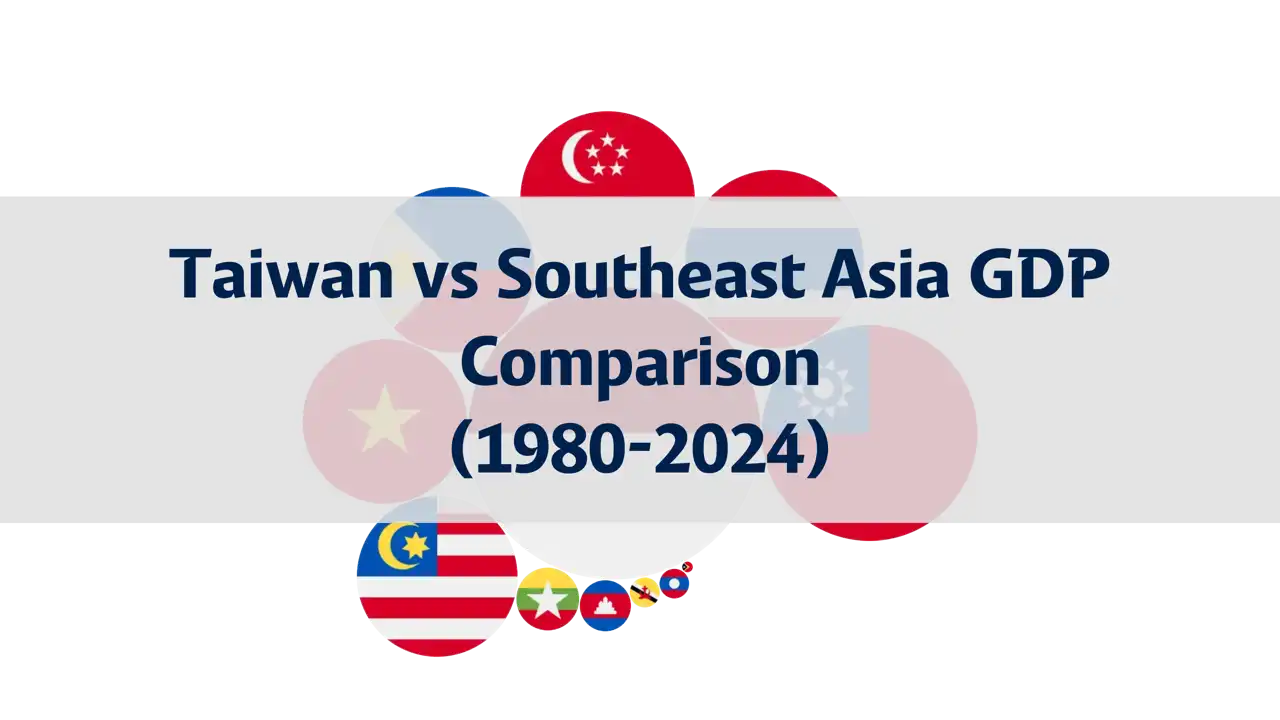
Taiwan vs Southeast Asia: 2023 GDP Comparison Unveils Surprising Rankings
- ASUMUP
- National Rankings / Asia & Oceania
- August 15, 2024
In 2023, the global economy faced numerous challenges, from inflationary pressures to geopolitical tensions. Amidst these challenges, the economies of Taiwan and Southeast Asia demonstrated resilience and growth. Comparing the Gross Domestic Product (GDP) of Taiwan and several Southeast Asian nations provides a fascinating insight into their economic standings and growth potential. GDP, representing the total market value of all goods and services produced in a country, is a key indicator of economic health. By examining these GDP figures, we can better understand the economic power dynamics within the region. Taiwan, often regarded as a tech powerhouse, competes economically with larger and smaller Southeast Asian nations, each of which has its unique economic drivers and challenges. This comparison will shed light on how these economies rank against each other and what this means for the region as a whole.
Taiwan vs Southeast Asia GDP Showdown
- 1st Indonesia - $1.4 trillion
- 2nd Thailand - $514.9 billion
- 3rd Singapore - $501.4 billion
- 4th Philippines - $436.6 billion
- 5th Vietnam - $433.7 billion
- 6th Malaysia - $415.6 billion
- 7th Myanmar - $64.5 billion
- 8th Cambodia - $41.9 billion
- 9th Laos - $15.2 billion
- Taiwan - $756.6 billion
Taiwan - $756.6 billion
Taiwan, with a GDP of approximately $756.6 billion in 2023, stands as the second-largest economy in this comparison, trailing behind Indonesia. Taiwan's economy is heavily driven by its robust technology sector, including the production of semiconductors, which are vital to global technology supply chains. The island's focus on innovation and high-value manufacturing has allowed it to maintain a strong economic position despite its relatively small population. Compared to Southeast Asian nations, Taiwan's economy is less reliant on traditional industries like agriculture or resource extraction, allowing it to achieve a higher GDP per capita. However, Taiwan's economic growth faces challenges from geopolitical tensions and dependency on exports, particularly to China. The comparison with Southeast Asian economies highlights Taiwan's strengths in high-tech industries but also underscores its vulnerability to global economic shifts.
9th Laos - $15.2 billion
Laos, with a GDP of approximately $15.2 billion in 2023, ranks tenth and is the smallest economy in this comparison. Laos is a landlocked country with an economy that relies heavily on agriculture, hydropower, and mining. Despite its small size, Laos has been working to develop its infrastructure and increase its connectivity within the region. However, Laos faces significant challenges, including a lack of diversification, limited access to international markets, and a need for greater economic reform. Compared to Taiwan, Laos' economy is at a much earlier stage of development, with limited industrialization and a heavy reliance on primary industries. The stark contrast in GDP between Laos and Taiwan illustrates the varying levels of economic development in Asia.
8th Cambodia - $41.9 billion
Cambodia, with a GDP of approximately $41.9 billion in 2023, ranks ninth in this comparison. Cambodia's economy is primarily driven by agriculture, tourism, and garment manufacturing. The country has been growing steadily, with significant contributions from foreign investment and development aid. Cambodia's garment industry, which exports mainly to the United States and Europe, is a major source of employment and foreign currency. However, Cambodia's economy faces challenges such as limited infrastructure, low educational levels, and a narrow industrial base. In comparison to Taiwan, Cambodia's economy is much smaller and less diversified, with a focus on a few key sectors rather than the advanced manufacturing and technology industries that characterize Taiwan's economic structure.
7th Myanmar - $64.5 billion
Myanmar, with a GDP of approximately $64.5 billion in 2023, ranks eighth among the countries in this comparison. Myanmar's economy is largely based on agriculture, with rice being the dominant crop. The country has vast natural resources, including oil, gas, and minerals, but political instability and lack of infrastructure have hindered economic development. Myanmar's economic growth has been further impacted by recent political turmoil, which has led to international sanctions and reduced foreign investment. Compared to Taiwan, Myanmar's economy is much less developed and heavily reliant on its primary sector. The significant gap in GDP between Myanmar and Taiwan highlights the disparities in economic development and industrialization between these two regions.
6th Malaysia - $415.6 billion
Malaysia, with a GDP of approximately $415.6 billion in 2023, ranks seventh in this comparison. The Malaysian economy is diversified, with strong sectors in manufacturing, particularly electronics, and commodities like oil and gas. Malaysia's well-developed infrastructure and strategic location have made it a key player in regional trade. Additionally, the country is focusing on high-value industries such as biotechnology and aerospace to drive future growth. When compared to Taiwan, Malaysia's economy is similarly diversified but relies more heavily on its natural resources. The two economies differ significantly in terms of industrial specialization, with Taiwan focusing more on technology and Malaysia on a broader range of manufacturing and resource extraction.
5th Vietnam - $433.7 billion
Vietnam follows closely with a GDP of approximately $433.7 billion in 2023, ranking sixth among the listed economies. Vietnam's economy has been one of the fastest-growing in Southeast Asia, driven by its manufacturing sector, which benefits from a young workforce and competitive labor costs. The country has become a global hub for electronics, textiles, and footwear production, attracting significant foreign direct investment (FDI). Vietnam's strategic trade agreements and open economic policies have further boosted its growth. In comparison to Taiwan, Vietnam's economy is in a more developmental stage, with a focus on attracting investment and growing its industrial base. While Taiwan is more established in high-tech manufacturing, Vietnam offers an attractive alternative for companies seeking cost-effective production.
4th Philippines - $436.6 billion
The Philippines, with a GDP of approximately $436.6 billion in 2023, ranks fifth in this comparison. The Philippine economy is driven by a mix of services, manufacturing, and agriculture, with a significant contribution from overseas remittances sent by Filipinos working abroad. The services sector, particularly business process outsourcing (BPO), is a major growth driver, attracting investment due to the country's large English-speaking population. The manufacturing sector is also growing, with electronics and automotive parts being key exports. Compared to Taiwan, the Philippines has a larger and younger population, which provides potential for future growth but also presents challenges in terms of employment and infrastructure development. The country’s economy is less specialized than Taiwan’s, with significant contributions from various sectors rather than a single dominant industry.
3rd Singapore - $501.4 billion
Singapore, with a GDP of approximately $501.4 billion in 2023, ranks fourth in this comparison. Despite its small size, Singapore has a highly developed and free-market economy, known for its business-friendly environment, strong financial sector, and status as a global trade hub. The city-state's economy is characterized by a high degree of openness and reliance on exports, particularly in electronics, chemicals, and financial services. Singapore's strategic location at the crossroads of major shipping routes has also cemented its position as a leading maritime center. When compared to Taiwan, Singapore's economy shares similarities in its focus on high-value industries, but it is even more concentrated in the services sector. Both economies face challenges related to their reliance on global trade and external demand.
2nd Thailand - $514.9 billion
Thailand ranks third with a GDP of approximately $514.9 billion in 2023. The Thai economy is well-known for its tourism industry, which plays a significant role in its GDP, alongside manufacturing and agriculture. Thailand is a major exporter of electronics, automobiles, and agricultural products, which are crucial for its economic stability. Despite being smaller than Taiwan's economy, Thailand benefits from a balanced mix of industries and a strategic location that makes it a hub for trade and tourism in Southeast Asia. However, Thailand faces economic challenges, including political instability and reliance on exports, which can be vulnerable to global market shifts. When compared to Taiwan, Thailand's economy is more diverse but less specialized, relying more on tourism and agriculture.
1st Indonesia - $1.4 trillion
Indonesia leads the pack with a GDP of approximately $1.4 trillion in 2023, making it the largest economy among Taiwan and the Southeast Asian countries listed. Indonesia's economy is diverse, with key sectors including manufacturing, agriculture, and services. The country's large population and natural resources, such as oil, gas, and minerals, significantly contribute to its GDP. Additionally, Indonesia has been experiencing steady economic growth due to increasing domestic consumption and investment in infrastructure. Compared to Taiwan, Indonesia's economy benefits from its larger domestic market, which provides a buffer against global economic fluctuations. However, challenges such as corruption, income inequality, and environmental concerns could impact Indonesia's long-term growth prospects.
Other Posts in the National Rankings / Asia & Oceania
Categories
- National Rankings(43)
- Science & Technology(1)
- Sports(24)
- Economy(30)
- Society(12)
- Culture(7)
Recent Posts
![Bayern Spent HOW MUCH on Harry Kane?! Ranking Their Top 10 Biggest Signings Ever]() A deep dive into Bayern Munich's ten most expensive transfers, exploring how the club's spending strategy has evolved to chase European glory.
A deep dive into Bayern Munich's ten most expensive transfers, exploring how the club's spending strategy has evolved to chase European glory.![Arsenal's Record-Shattering Spree: From a €116M Gamble to a Flop, Who Was Worth the Cash?]() A deep dive into Arsenal's top 10 most expensive signings, analyzing the successes, the failures, and the massive fees that have defined the club's modern transfer strategy.
A deep dive into Arsenal's top 10 most expensive signings, analyzing the successes, the failures, and the massive fees that have defined the club's modern transfer strategy.![Chelsea Cashes In BIG TIME! Who Really Won the 25/26 Summer Transfer Window Money Game?]() A deep dive into the top 10 clubs that made the most money from player sales during the wild 25/26 summer transfer window.
A deep dive into the top 10 clubs that made the most money from player sales during the wild 25/26 summer transfer window.![Liverpool's Record-Breaking €483M Spree! Did They Just Buy the Premier League Title?]() A deep dive into the 25/26 summer transfer window reveals Liverpool's record-breaking spending spree as Premier League clubs continue to dominate the market.
A deep dive into the 25/26 summer transfer window reveals Liverpool's record-breaking spending spree as Premier League clubs continue to dominate the market.![You Won't Believe How Much a Loaf of Bread Costs in These Countries! (Spoiler: It's INSANE)]() This post explores the top 10 countries with the most expensive bread, revealing how factors like import reliance and tourism dramatically inflate the cost of this basic staple.
This post explores the top 10 countries with the most expensive bread, revealing how factors like import reliance and tourism dramatically inflate the cost of this basic staple.
















